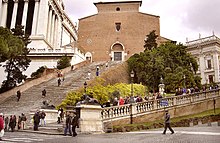Aracoeli
| Basilica of St. Mary of the Altar of Heaven Basilica di Santa Maria in Ara coeli (Italian) Basilica Sanctae Mariae de Ara coeli (Latin) |
|
|---|---|

Façade of the Basilica with the monumental staircase.
|
|
| Basic information | |
| Location | Rome, Italy |
| Geographic coordinates | 41°53′38″N 12°29′00″E / 41.89389°N 12.48333°ECoordinates: 41°53′38″N 12°29′00″E / 41.89389°N 12.48333°E |
| Affiliation | Roman Catholic |
| Country | Italy |
| Ecclesiastical or organizational status | Minor basilica |
| Leadership | Salvatore De Giorgi |
| Website | Official Website |
| Architectural description | |
| Architectural type | Church |
| Architectural style | Romanesque, Gothic |
| Completed | 12th century |
| Specifications | |
| Direction of façade | West by South |
| Length | 80 metres (260 ft) |
| Width | 45 metres (148 ft) |
| Width (nave) | 20 metres (66 ft) |
The Basilica of St. Mary of the Altar of Heaven (Latin: Basilica Sanctae Mariae de Ara coeli in Capitolium, Italian: Basilica di Santa Maria in Ara coeli al Campidoglio) is a titular basilica in Rome, located on the highest summit of the Campidoglio. It is still the designated Church of the city council of Rome, which uses the ancient title of Senatus Populusque Romanus. The present Cardinal Priest of the Titulus Sancta Mariae de Aracoeli is Salvatore De Giorgi.
The shrine is known for housing relics belonging to Saint Helena, mother of Emperor Constantine, various minor relics from the Holy Sepulchre, both the canonically crowned images of Nostro Signora di Mano di Oro di Aracoeli (1636) on the high altar and the Santo Bambino of Aracoeli (1897).
Originally the church was named Sancta Maria in Capitolio, since it was sited on the Capitoline Hill (Campidoglio, in Italian) of Ancient Rome; by the 14th century it had been renamed. A medieval legend included in the mid-12th-century guide to Rome, Mirabilia Urbis Romae, claimed that the church was built over an Augustan Ara primogeniti Dei, in the place where the Tiburtine Sibyl prophesied to Augustus the coming of the Christ. "For this reason the figures of Augustus and of the Tiburtine sibyl are painted on either side of the arch above the high altar" (Lanciani chapter 1). A later legend substituted an apparition of the Virgin Mary. In the Middle Ages, condemned criminals were executed at the foot of the steps; there the self-proclaimed Tribune and reviver of the Roman Republic Cola di Rienzo met his death, near the spot where his statue commemorates him.
...
Wikipedia
